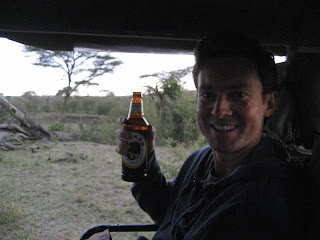Lets start with a little bit of reflection. I updated last year's brewing goals with my actual results.


Favorite Homebrews of 2011:
1. Old Ale with Avery 15 dregs - I find this Brett strain(s) to just produce my favorite flavors, which are tropical fruits when it is young and then transitions to a nice funk, but never gets close to fecal or "goaty". This beer has a great richness about it. The aroma is pineapple, guava, pear and caramel malt with a sour tinge. The taste is very complex and the main reason I like it so much. You get the fruity flavors first, then sourness (more tart than sour), then it finishes with a great toffee aftertaste that stays with you.
2. Dark Saison (Soured Version) - This one took a bit of aging for the flavors to meld together. Once it did, the flavor complexity (see trend) won me over. Saison spice up front, then sourness (mid to high), and ends with a warm dark fruit flavor.
3. Best Bitter (Fullers Version) - I have not posted a tasting yet, but this beer is long gone. It was consumed quickly. The malt profile is exactly where I want it. It has this great crispy butter (not diacetyl buttery) cracker flavor. The hop aroma is still lacking a bit, I think that I need to convert over to whole leaf hops for dry-hopping.

It is amazing how my beer preference is continually changing. Here is my wish list for next year.
Jan. 2012:
Parti-gyle Stout Experiment:
5 gal Oatmeal Stout
1 gal batch – Stout with Maple candy
 5 gal Imperial Stout
5 gal Imperial Stout
2.5 gal batch – French Oak + Cacao Nibs + Vanilla Beans
Feb. 2012:
Scottish 60/80
1 gal batch – Scottish 60- with Cedar1 gal batch – Scottish 80- with French Oak
March 2012:
Wee Heavy
1 gal batch – Wee Heavy with Avery 15 dregs
April 2012:
Barleywine 1 gal batch – Barleywine with French Oak
1 gal batch – Barleywine with Minced Meat
May 2012: Table Saison


 5 gal split batch – 2 different Saison Strains
5 gal split batch – 2 different Saison Strains
1 gal batch – Orval dregs
Flanders Red
1 gal batch – 1 year old Flander’s Red on Sour Cherries
June 2012: Summer Saison
1 gal batch – St. Somewhere dregs
July 2011:
Dark Saison
1 gal batch – TBD dregs
August 2012:
Belgian Singel
5 gal split batch – 2 different Belgian Strains
Sept. 2012:
Belgian Dubbel
1 gal batch - Belgian Dubbel with Achel dregs
Homegrown Pale Ale
Belgian Dark Strong
1 gal batch – Belgian Dark Strong with Red Poppy dregs
Oct 2012:
Best Bitter5 gal split batch – 2 different English Strains
Nov 2012:
English Dark Mild
5 gal split batch – 2 different English Strains
Oud Bruin
1 gal batch – Oud Bruin with Holiday Party Dregs
Dec 2012:
ESB
2011 Brewing Goals (Updated)


Favorite Homebrews of 2011:
1. Old Ale with Avery 15 dregs - I find this Brett strain(s) to just produce my favorite flavors, which are tropical fruits when it is young and then transitions to a nice funk, but never gets close to fecal or "goaty". This beer has a great richness about it. The aroma is pineapple, guava, pear and caramel malt with a sour tinge. The taste is very complex and the main reason I like it so much. You get the fruity flavors first, then sourness (more tart than sour), then it finishes with a great toffee aftertaste that stays with you.
2. Dark Saison (Soured Version) - This one took a bit of aging for the flavors to meld together. Once it did, the flavor complexity (see trend) won me over. Saison spice up front, then sourness (mid to high), and ends with a warm dark fruit flavor.
3. Best Bitter (Fullers Version) - I have not posted a tasting yet, but this beer is long gone. It was consumed quickly. The malt profile is exactly where I want it. It has this great crispy butter (not diacetyl buttery) cracker flavor. The hop aroma is still lacking a bit, I think that I need to convert over to whole leaf hops for dry-hopping.

It is amazing how my beer preference is continually changing. Here is my wish list for next year.
Jan. 2012:
Parti-gyle Stout Experiment:
5 gal Oatmeal Stout
1 gal batch – Stout with Maple candy
 5 gal Imperial Stout
5 gal Imperial Stout2.5 gal batch – French Oak + Cacao Nibs + Vanilla Beans
Feb. 2012:
Scottish 60/80
1 gal batch – Scottish 60- with Cedar1 gal batch – Scottish 80- with French Oak
March 2012:
Wee Heavy
1 gal batch – Wee Heavy with Avery 15 dregs
April 2012:
Barleywine 1 gal batch – Barleywine with French Oak
1 gal batch – Barleywine with Minced Meat
May 2012: Table Saison


 5 gal split batch – 2 different Saison Strains
5 gal split batch – 2 different Saison Strains 1 gal batch – Orval dregs
Flanders Red
1 gal batch – 1 year old Flander’s Red on Sour Cherries
June 2012: Summer Saison
1 gal batch – St. Somewhere dregs
July 2011:
Dark Saison
1 gal batch – TBD dregs
August 2012:
Belgian Singel
5 gal split batch – 2 different Belgian Strains
Sept. 2012:
Belgian Dubbel
1 gal batch - Belgian Dubbel with Achel dregs
Homegrown Pale Ale
Belgian Dark Strong
1 gal batch – Belgian Dark Strong with Red Poppy dregs
Oct 2012:
Best Bitter5 gal split batch – 2 different English Strains
Nov 2012:
English Dark Mild
5 gal split batch – 2 different English Strains
Oud Bruin
1 gal batch – Oud Bruin with Holiday Party Dregs
Dec 2012:
ESB






































